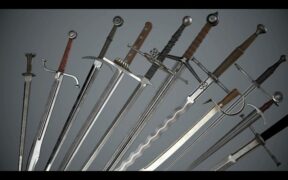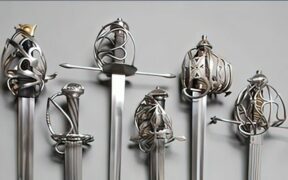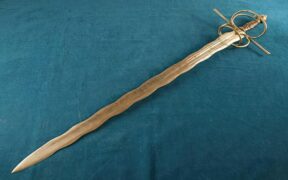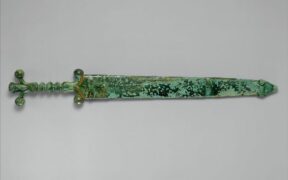Our content features commercial links to our products, committed to transparent, unbiased, and informed editorial recommendations. Learn More
Falchion Sword: Its Types, History, and Use
NO AI USED This Article has been written and edited by our team with no help of the AI
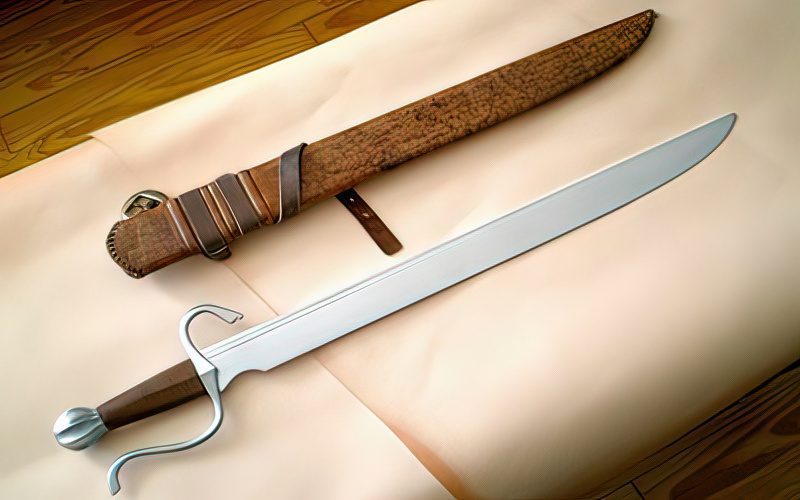
Widespread throughout the Middle Ages, a falchion was a heavy, single-edged sword with a blade that widened towards the tip. However, there were several variations to its basic pattern, ranging from machete-like cleavers to narrower blades with a clipped point. The light troops such as archers and spearmen, favored the falchion for its efficiency in chopping.
Let’s explore the different types of falchion swords, their history, and how they compare to other medieval swords.
Types of Falchion Swords
During the later Middle Ages, there were two distinct types of falchion. The first type is similar to a butcher’s cleaver, while the other resembles a sabre blade. However, there may be several subtypes for several historical examples.
1. Conyers Falchion
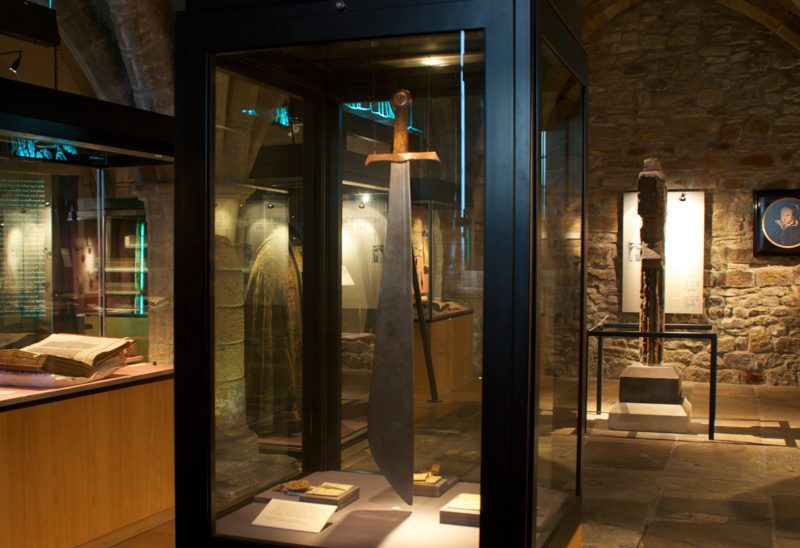
Named after the family who owned it, the Conyers falchion is similar to a modern cleaver or machete. It has a straight blade that broadens toward the tip, with a pronounced convex curve. It is a chopping weapon that could inflict great damage even in unskilled hands.
The Conyers’ falchion is one of a few surviving examples of a cleaver-type falchion widely used during the mid-13th century. On the pommel, it featured the heraldic arms of the Plantagenet kings of England and Richard Earl of Cornwall.
The falchion swords are widely portrayed in medieval art, though the cleaver-like blades rarely appeared after about 1370. Today, the famous Conyers’ falchion is preserved in the library of Durham Cathedral in England.
2. Thorpe Falchion
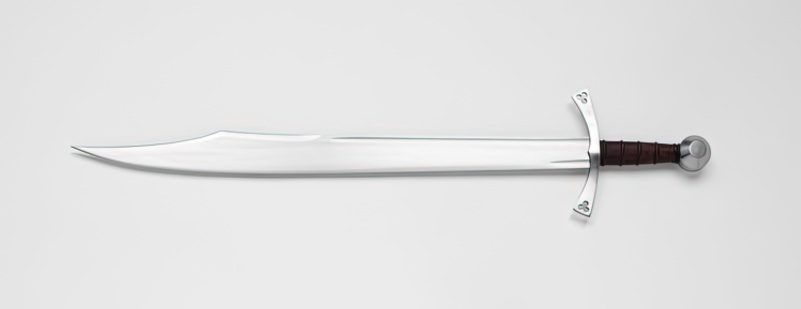
Named after the place where it was found, the Thorpe falchion is an example of the typical cusped falchion, in which its point has a cusped, beak-like shape. Its cusped point made it efficient for cutting and thrusting. This type sometimes had a straight or curved blade, similar to a scimitar.
However, it remains unclear how the falchion developed into a saber-like blade. Some historians suggest that the blade form was influenced by Eastern European swords. The Thorpe falchion is similar to the Sword of Charlemagne—the saber type kept in Vienna, Austria—which had been widely used in Eastern Europe since the 9th century. Still, it is considered an English weapon.
The most popular depiction of a Thorpe- or cusped-type falchion comes from medieval art, particularly the 1470s The Battle of the Naked Men engraving by Antonio Pollaiuolo. This type of falchion sword remained in use from the early 14th century until the 16th century, with modifications and in insignificant little weapons.
Characteristics of Falchion Swords
A falchion is most recognized for its function as a chopping weapon, as its blade form varied in history. Several replicas today are inspired by the Conyers or the Thorpe falchion with various modifications.
Here are the characteristics of the falchion sword:
Metal and Construction
The medieval falchions were not of high quality, as only a few historical examples survive today. Some falchions were even made from shortened or reshaped broken swords as it was common in medieval times to recycle weapons for other use.
Modern replicas are often made of high-carbon steel and the so-called battle-ready swords have properly tempered blades. Falchions are also popular in stage combat and live-action role-playing (LARP), ideally suited for their specific use.
Blade Appearance
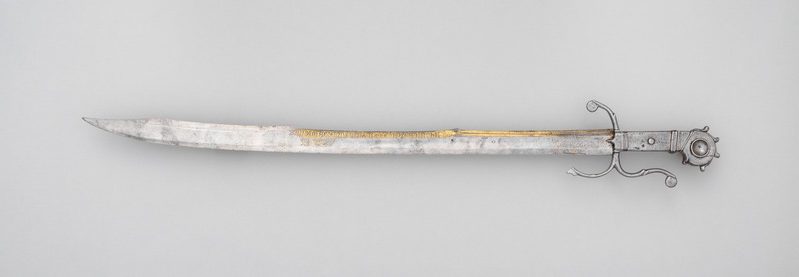
A falchion was a single-edged sword, though blade designs varied. Generally, its heavy and broad blade was designed for powerful chopping strokes similar to a machete or meat cleaver. The earlier falchions, such as the Conyers type, tended to have curved points. On the other hand, the later falchions of the Thorpe type featured a cusped point.
| Type of Falchion | Earlier Falchions (Conyers type) | Later Falchions (Thorpe type) |
|---|---|---|
| Blade Shape | Machete- or cleaver-like blade | Saber-like blade |
| Tapering | A straight blade that widens toward the tip | A straight or curved blade that broadens near the tip |
| Point | Curved or rounded point | Cusped or clipped point |
| Use | Efficient only for chopping. | Its sharpened false edge makes it efficient in both thrusting and chopping. |
| Fuller/Groove | Most were without fuller; others had shallow fullers. | Has a single fuller on one side of the blade. |
Size and Weight
A falchion varied greatly in size, with its average blade length ranging from 45 to 65 centimeters (17 to 25 inches). With their broad blades, falchions were usually less maneuverable, weighing about 2 to 3 pounds.
Sword Mounting
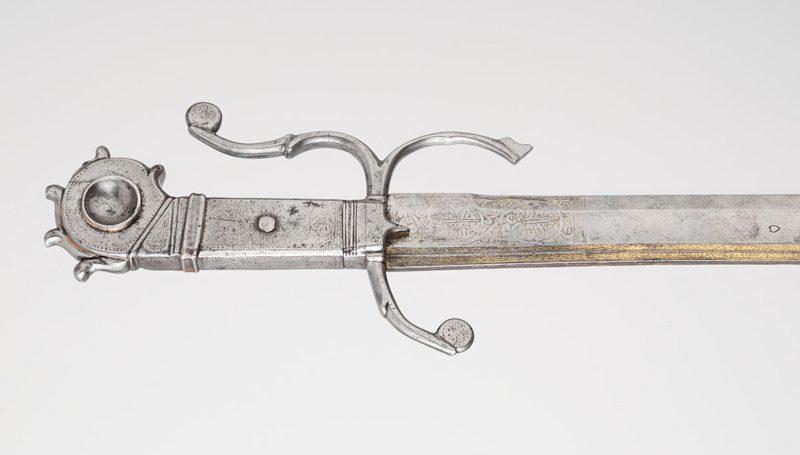
Some early falchions had no sword guards, though most later ones had crossguards or S-shaped guards. By the mid-15th century, they were among the first European blades to have knuckle guards. Also, almost all falchions had single-handed grips, and some had a black sheath or scabbard.
Its crossguard and pommel were often decorated with foliage patterns, dragons, and wyverns. Others had a pommel bearing heraldic symbols such as the leopards of England or the eagle of the Holy Roman Empire.
Was The Falchion a Good Sword?
A falchion was a practical and lethal chopping weapon as it needed little training to be efficient on the battlefield. Most were short enough to be handy in close-quarters combat yet could deliver heavy blows.
Generally, a falchion-armed soldier, such as an archer and the like, would aggressively strike whatever targets and defeat their opponents before they could attack them. The tactics might have included attacking the enemies from the flank or behind.
Unlike other medieval swords, the falchion was functional for war and hunting. They likely served as a general tool outside combat. The commoners also owned falchions and probably used them for chopping wood and more.
Falchions vs. Arming Swords
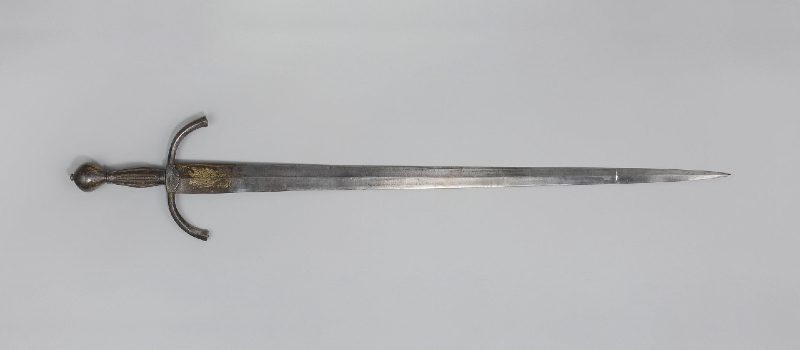
Sometimes called knightly swords, the arming swords were single-handed swords efficient against chainmail. They were the typical crusader swords used from the late 11th century onwards. Generally, the falchion was shorter than an arming sword—even though many erroneously call the latter a short sword to differentiate it from the longsword with a longer grip.
A falchion had a single-edged blade while an arming sword had a double-edged blade. The falchion relied on heavy, broad blades for maximum cutting power, though they were too unbalanced to thrust well. On the other hand, the arming swords were well-balanced and more maneuverable cut-and-thrust weapons.
Falchions vs. German Messers

A messer is a weapon similar to the falchion used in medieval Germany from the 14th century onwards. The name messer literally means knife, though its size varied greatly. A langes messer was a long knife while a grosse messer means big knife.
A messer had a falchion-like single-edged blade with a sharp cutting edge, though blade forms varied. It was a sidearm of a common foot soldier, such as an arquebusier or pikeman. Like the falchion, commoners who may not have had any training, also used the messer as a sidearm.
Messer combat would involve simple yet lethal attacks, such as swinging a heavy blade. However, messer combat typically targeted the hand of the opponent. Like the falchion, a messer was efficient for slashing and powerful enough to slice off a hand with a single blow.
Falchions vs. Broadswords
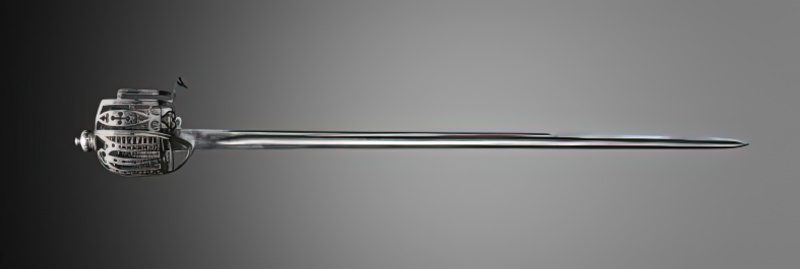
There are various types of broadswords, but they generally have a straight, double-edged blade. They often featured a basket hilt giving excellent hand protection. The most popular types are the Scottish basket-hilted broadswords and the Venetian schiavona.
Unlike a falchion, a broadsword could cut both ways, allowing the swordsman to make a fast, immediate cut after a failed attack without turning his sword. Contrary to the falchion sword which mainly served as an infantry weapon, most broadswords were used from horseback.
History of the Falchion Sword
Throughout history, the falchion served not only as a weapon, but also a symbol of tenure, the right to own property, and a mark of grants in recognition of service. In England, three famous families commemorated their acquisition of territory with a falchion.
- The name falchion comes from the Latin falx, meaning sickle.
The term falchion may come from the French fauchon (sickle) or the British faussart, which is associated with the Latin falx. Some also associate it with the Iberian falcata, as bending it straight would result in a falchion. However, the term falcata is an invention of 19th-century scholars, so we cannot conclude that the name falchion came directly from it.
- The falchion evolved from the Norse sax, a single-edged fighting knife.
Also spelled seax in Old English, the Norse sax had a broad and heavy blade with an angled point ideal for thrusting. Even though fighting knives can be used for slashing, they lack the efficiency of larger blades for heavy, chopping actions. The Norse sax and similar weapons were widely used all over Europe, especially by the Vikings and the Anglo-Saxons.
- The Conyers falchion served as a symbol of tenure.
The Conyers family presented the falchion to the Bishop of Durham when he first arrived at the diocese. In return, the family held the manor of Sockburn in County Durham. In order to show their right to the tenure of lands, the ceremony of presenting the Conyers falchion was enacted again every time a new Bishop entered Durham for the first time.
- Medieval legends are attached to the Conyers’ and Pollards’ falchions.
In 1063, Sir John Conyers killed a wyrm, a mythical dragon-like creature ravaging the region. So, the bishop gave the manor to his family and the presentation of the sword served as a reminder of the act. On the other hand, the Pollard falchion was owned by the Pollards who also held several properties in Durham. It was associated with the family’s slaying of a great boar.
- The Wigmore falchion served as a token of a grant.
The Wigmore falchion is believed to be the charter of the land of Wigmore. During the 14th century, Ralph de Mortimer was granted Wigmore by capturing Eadric “the Wild,” an English landholder who rebelled against King William I. Some also suggest that he was involved in putting down the Revolt of the Earls in 1075.
- The falchion most likely served as an infantry weapon.
Light troops such as archers and spearmen favored the falchion for its efficiency in chopping. Some historians argue that it cannot be used to draw-cut or thrust well on horseback, making it a better infantry weapon than a cavalry sword. In contemporary illustrations, the falchion is occasionally seen in the hands of knights, even though it is not typically considered a knightly weapon.
- By the 15th century, falchions became outmoded in favor of sabers.
During this time, the saber blade began to make its appearance in southern and western Europe. While the falchion is definitely European, the Western European sabers did not develop from the medieval falchion. In fact, sabers had been in use in the East for centuries. Those blades were the same shape and size as the English cavalry sabres of the 1796 patterns.
Conclusion
A falchion was a broad, machete-like chopping sword of medieval times and a powerful and symbolic weapon. Medieval light troops favored the falchion for its efficiency in chopping. Eventually, it became a symbol for commemorating martial victories and land ownership. Today, the falchions of the Conyers, Pollard, and Mortimer families remain a mystery.
